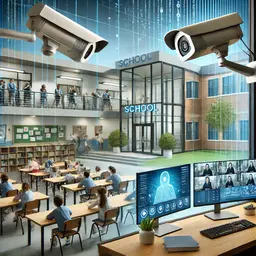
In educational institutions, where the safety of students and staff is paramount, a reliable video surveillance system is an essential tool for creating a secure and conducive learning environment. From monitoring hallways and classrooms to protecting campuses from external threats, video surveillance plays a vital role in safeguarding students, educators, and assets. Here, we explore the importance of video surveillance systems in the education industry, their key benefits, and how they can address unique challenges faced by schools, colleges, and universities.
Why Video Surveillance is Critical in Educational Institutions
- Ensuring Student and Staff Safety
Educational facilities are vulnerable to security breaches, bullying, and even criminal activities. A robust video surveillance system helps to:- Monitor student behavior to prevent bullying or physical altercations.
- Identify and respond to unauthorized individuals on campus.
- Assist in emergency situations, such as evacuations or lockdowns, by providing real-time visuals to first responders.
- Deterrence of Misconduct and Crime
The presence of visible cameras acts as a deterrent to theft, vandalism, and other criminal activities. For example:- Student Misconduct: Cameras discourage inappropriate behavior, ensuring that the institution maintains a respectful atmosphere.
- Theft Prevention: Monitoring areas like lockers, libraries, and parking lots helps prevent theft and ensures accountability.
- Improved Emergency Preparedness
During emergencies like fires, intrusions, or natural disasters, video surveillance systems provide:- Real-time visuals to security personnel and emergency responders.
- Insights for coordinating evacuations or lockdown procedures effectively.
- Asset Protection
Educational institutions often house expensive assets, including computers, lab equipment, and sports gear. Video surveillance ensures these assets are protected against theft or damage, reducing replacement costs and ensuring operational continuity. - Enhancing Parent and Community Trust
A well-implemented surveillance system reassures parents and the community that their children are in a safe, well-monitored environment. Transparency in security measures fosters trust and credibility.
Key Features of Effective Video Surveillance Systems for Education
- High-Definition Cameras
High-resolution cameras ensure clear visibility of activities across large campuses. Features like zoom and panoramic views help monitor critical areas like playgrounds, entrances, and parking lots. - Real-Time Monitoring and Alerts
Advanced systems integrate with centralized dashboards, allowing security personnel to monitor live feeds and receive alerts for suspicious activities, unauthorized access, or emergencies. - Cloud-Based Storage
Cloud storage ensures that video footage is securely stored offsite, protecting data from physical damage or theft. It also enables authorized users to access footage remotely for investigations or audits. - Integration with Access Control Systems
Modern surveillance systems can integrate with access control technologies like keycards or biometric scanners to track who enters and exits specific areas, such as labs or administrative offices. - AI-Driven Analytics
Artificial intelligence enhances video surveillance by enabling:- Facial recognition for identifying individuals.
- Behavior analysis to detect unusual or potentially harmful activities.
- Automated alerts for potential security breaches.
- Scalability and Flexibility
Educational institutions vary greatly in size and layout. A scalable surveillance system can be customized to cover campuses of all sizes, from small schools to sprawling universities.
Benefits of Video Surveillance in Education
- Promotes a Secure Learning Environment
By reducing threats and maintaining discipline, video surveillance creates a safe atmosphere where students and staff can focus on education without fear. - Assists in Conflict Resolution
Recorded footage provides unbiased evidence for resolving disputes or allegations, ensuring fair outcomes for students, staff, and parents. - Supports Regulatory Compliance
Many regions have specific security requirements for schools. A modern video surveillance system helps institutions comply with these regulations and avoid penalties. - Streamlines Campus Operations
By monitoring foot traffic patterns, administrators can optimize campus layouts and ensure efficient use of resources like entrances, cafeterias, and assembly halls. - Reduces Liability Risks
Video surveillance footage protects institutions from false claims and lawsuits by providing clear evidence in case of incidents.
Challenges and Considerations
While video surveillance systems are invaluable, they come with challenges that institutions must address:
- Privacy Concerns
Surveillance must strike a balance between safety and privacy. Clearly communicate policies to students, staff, and parents, ensuring compliance with privacy laws. - Initial Costs
Implementing a comprehensive system may require significant investment in cameras, storage, and infrastructure. However, the long-term safety and cost savings justify the expense. - Maintenance Requirements
Regular maintenance is essential to ensure cameras and systems remain operational. Institutions should partner with reliable vendors for ongoing support. - Cybersecurity Risks
Cloud-based systems must have strong encryption and access controls to prevent unauthorized access or data breaches.
Real-Life Applications of Video Surveillance in Education
- School Security
Cameras in hallways, entrances, and parking lots help monitor student activities and ensure safe arrivals and departures. - University Campuses
Large campuses benefit from advanced systems that integrate with emergency response platforms, enabling faster coordination during incidents. - Special Education Facilities
Surveillance systems can monitor interactions between students and staff to ensure the highest standards of care and accountability.
The Future of Video Surveillance in Education
Advancements in technology continue to enhance the capabilities of video surveillance systems. Here are some emerging trends:
- Smart Cameras with Edge Analytics
Cameras equipped with edge computing capabilities can analyze footage locally, reducing bandwidth usage and enabling faster responses. - IoT Integration
Video surveillance systems will increasingly integrate with Internet of Things (IoT) devices, such as smart lighting and door locks, to create smarter, more secure campuses. - AI-Powered Insights
Future systems will provide predictive analytics, helping institutions identify and address potential security threats before they occur. - Mobile Accessibility
Administrators and security teams will have greater access to live feeds and alerts through mobile apps, ensuring constant vigilance.
Conclusion
A reliable video surveillance system is no longer a luxury for educational institutions—it’s a necessity. By safeguarding students, staff, and assets, these systems foster a secure learning environment and enhance operational efficiency. As technology evolves, the role of video surveillance in education will only grow, offering smarter, more proactive solutions to meet the challenges of tomorrow.
Ready to enhance security in your educational institution? Contact us today to learn more about tailored video surveillance solutions.


